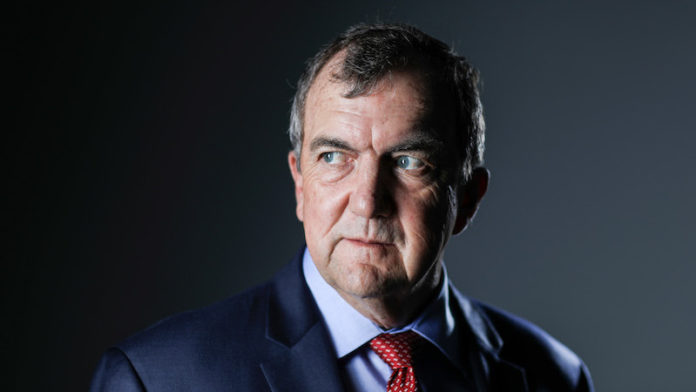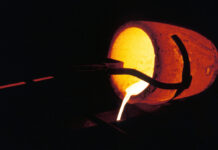
BARRICK Gold CEO Mark Bristow has been grumbling about other people’s deals for nearly three decades. Yet nearly every year the gold sector finds new ways to merge and acquire. This year, Newmont broke all records, buying Australia’s Newcrest Mining for $19.5bn. The deal takes Newmont’s gold production to nine million ounces a year. PwC, the auditor, forecast a ‘mega-deal’ in gold every few years, with at least one substantial deal every year.
“No-one spends any money on their own future through exploration,” says Bristow. His long-standing contention is that the market will reward Barrick for replacing production for the next decade at a cost cheaper than can be achieved in M&A. This approach at Randgold Resources, Bristow’s former company, earned it a premium rating and led to its merger with Barrick in 2019.
Lately, however, there seems to have been a slight switch in Bristow’s thinking. In 2020, he offered to buy Grasberg, a copper mine in Indonesia, from Canadian firm Freeport-McMoRan. This year, Bristow was linked with the takeover of First Quantum Minerals. The two targets have one thing in common: they produce copper, which Bristow thinks has strategic relevance that makes deals in the metal different to gold.
Newmont would agree. Its swoop on Newcrest takes its copper output to 350 million pounds annually, rivalling Barrick, which has forecast production of up to 470 million pounds of the red metal this year. “I think with the big copper deals there’s a lot of upside in the price,” says Bristow. “We have a view about copper and gold: when we announced the Barrick deal, I was very clear this is a copper and gold company. The logic is it comes together.”
Gold’s fortunes are intrinsically linked to global economic conditions. In high inflationary environments, such as the current one, the metal is popular. Political shocks also boost its price. In more sanguine economic times, gold underwhelms. Over time, the metal is a proven portfolio hedge. It’s different for copper, however. Government-sanctioned efforts to lower greenhouse gas emissions are forecast to underpin its price for years to come given copper’s heavy usage in renewable energy and electric mobility. “We forecast copper demand in renewable energy to increase from 997,000 tons in 2020 to 1.9 million tons in 2030,” said Jefferies, a bank.
Bristow also says gold miners have no choice but to accept copper into their portfolios because new gold discoveries are predominantly porphyries which are copper containing. He also thinks the structure of ownership in copper output needs to be changed to achieve the best investment outcomes – something investment banks have yet to get their heads around. “The rest of the mining industry has to reallocate its assets or rearrange it because a copper mine in BHP or a copper mine in Rio, you lose it.”
For now, though, Barrick has drawn a blank in the M&A market. Instead, Bristow has focused on improving the operational performance of Barrick’s existing copper mines, such as Lumwana in Zambia, which at 267,000 pounds last year accounted for roughly half of Barrick’s copper output.
Asked about Grasberg, Bristow says the deal no longer holds any interest for him. Freeport rebuffed Barrick when it was valued at $10bn. Freeport is worth $55bn today, which has removed the cut-price attractiveness of the deal. In any event, improvements at assets such as Lumwana and another mine – Barrick’s 50% stake in Jabal Sayid in Saudi Arabia – means the company has “outgrown” it, says Bristow.
As for the recent speculation linking Barrick with First Quantum, Bristow says he’s “aggressively no” about responding to any speculation. “Since the day I arrived in Canada, people will take up trading positions, saying we’re interested in this or that company.” So he won’t comment either way. Nonetheless, there’s a value argument for Barrick tilting at First Quantum in the same way it looked at Freeport. First Quantum has underperformed its copper-producing peer group, gaining only 27% in 12 months. This compares to a 38% gain for Freeport over the same period, a 49% gain for Canadian firm Teck Resources (which is under bid by Glencore), and a 38% gain for Southern Copper.
BRISTOW is these days rarely a visitor to South Africa, the country of his birth. His family relocated, and only a brother, John – a prominent diamond industry entrepreneur – remains. But he was in Johannesburg at the time of writing, ahead of a five-week tour of Barrick’s operations. It started in Africa before he headed for Saudi Arabia, Pakistan, Papua New Guinea and finally the Dominican Republic for the quarterly overview of the Americas leg. It’s a trip he does, apparently tirelessly, every quarter, every year. It was the same at Randgold. A geologist by training, Bristow is obsessed with the mines.
Asked about South Africa, he is unstintingly critical. “The cost of living and doing business is still very low compared to the rest of Africa. The people are very competent; in fact, exceptional. But doing business, anything to do with the business side of things – it’s a huge disappointment,” he says. That’s because the business environment isn’t conducive – a criticism that abounds about South African mining both within the country and internationally.
“Cyril [Ramaphosa, South African president] is very disappointing. Gwede Mantashe [mines and energy minister] is a clown,” says Bristow.
Despite this, he thinks it was a mistake for AngloGold Ashanti to have moved its primary listing from Johannesburg to New York, a transaction that cost about $500m. “There’s no way they should have left,” he says. Better to be a big fish in the relatively small emerging market investment pool, seems to be his attitude. “For me, when you do that move, you get out of the emerging market indices.” He’s also noticed the difference having taken Randgold out of emerging market indices post the Barrick merger: “So we’ve got work to do.”
Alberto Calderon, CEO of AngloGold Ashanti, has defended his firm’s move, saying it will line up for cheaper capital and enable the company to trade at a better rating. Bristow, however, doesn’t think the South African discount is real: “I still strongly believe that the missed opportunity was the merger between Gold Fields and AngloGold,” he says.
“We tried to help do that transaction because we were interested in Kibali, and we could fund it in a transaction,” he says. In terms of this arrangement, Sibanye-Stillwater was to buy AngloGold and Gold Fields and recoup cash by selling AngloGold’s 50% stake in the Congo mine it shares with Barrick.
The deal never happened, ending the notion of a South African mining champion that Sibanye CEO Neal Froneman was keen to create.
What’s happened instead is a retreat from South Africa’s gold mining sector from nearly all its major participants. Even Harmony, a stalwart of the local industry, bought a copper project in Australia last year. Harmony also has an option on another copper project – Wafi-Golpu, in Papua New Guinea. The balance of the project was formerly owned by Newcrest, now Newmont, following their merger. Asked if he’d be interested in buying Harmony, hiving off its South African mines and becoming a joint venture partner with Newmont in Wafi-Golpu, Bristow gives a firm “no thanks”.
“I’m not interested in Wafi-Golpu,” he says. “We looked hard at Newcrest. I was very clear, I think it was like 40 minutes after the announcement [of Newmont bidding for Newcrest] that we’re not interested.”
FOUR years into running Barrick, the company seems to be operating pretty much as Bristow wants; which is to say, like Randgold. Only in Toronto is Bristow’s office not a hot desk. The Bay Street headquarters now house a few hundred people compared to 1,200 several years ago. Power is decentralised to the mines, which run by CEOs rather than mine managers.
At 64 years, the obvious question is whether Bristow has given consideration to retirement. While not directly answering the question, he doesn’t seem minded right now. A “very serious” debate about succession happens with the board every year, but it’s a conversation about succession throughout the group rather than just his seat. Bristow wants to avoid sheltering ‘pets’ or cells of friendship and preference in a business section.
“My philosophy in management is when you employ somebody and they bring five people with them, don’t deploy them because you create a liability. If they leave, the other four go with them. It’s like Mark Cutifani and that technical guy that he dragged around his whole career,” says Bristow of the former Anglo American CEO and Tony O’Neill, its former technical director.
To say Bristow is forthright is something of an understatement. But with this track record running Randgold and now Barrick, it’s hard to make an objection. Randgold grew from a (nearly broke) single-asset producer in the 1990s to a one-million-ounce-a-year racing car of a gold company the London market is yet to fully replace. It was the only gold company not to impair an asset following the market correction after 2010 (and all of them were taking heavy write-downs from BHP, to Rio, to Barrick itself at its Pascua-Lama mine in Chile). It earned Bristow a place in the top 25 of CEOs globally in the Harvard Business Review of 2016.
Even after the merger with Barrick, Bristow says the African assets that made up Randgold proved the most resilient. While he was restructuring Barrick, Loulo-Gounkoto in Mali and Kibali in the Democratic Republic of Congo barely missed a beat. It enabled Bristow to focus on Barrick’s troublesome assets in South America and elsewhere. He revived its copper portfolio and restarted Reko Diq, a project in Pakistan that had been mired in dispute for years. Another dispute-hit asset was Barrick’s Tanzanian mines.
Labouring under an export ban during the presidency of the late John Magufuli amid claims of malfeasance, Bristow stopped the litigation and paid the government $300m in reparations. He also divided the assets in half, giving the government a 50% stake in a newly formed joint venture. North Mara, one of the Tanzanian mines, is now being developed into one of Barrick’s top mines.
One irony of his 30 years in mining, however, is that Bristow has become part of the establishment. As founder of Randgold Resources he played the role of enfant terrible. He famously laid into Barrick itself for its corporate excesses, labelling it part of the “old school tie” that dominated in the gold sector. But as CEO of that company itself, the iconoclast has become the icon. “A big, larger-than-life, alpha-male personality,” is how Investec analyst Hunter Hillcoat described Bristow to Bloomberg News in 2018.











